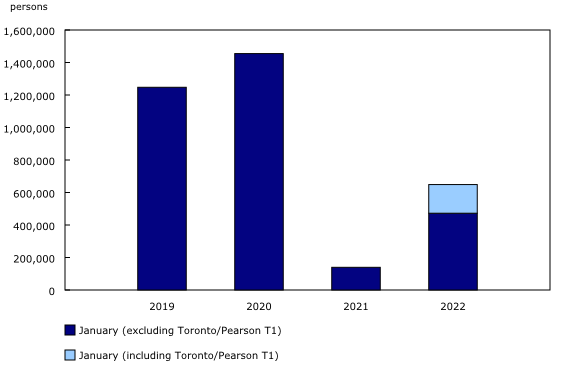Leading indicator of international arrivals to Canada, January 2022
Archived Content
Information identified as archived is provided for reference, research or recordkeeping purposes. It is not subject to the Government of Canada Web Standards and has not been altered or updated since it was archived. Please "contact us" to request a format other than those available.
Released: 2022-02-11
Highlights
In January, the number of international visitors to Canada rose from January 2021, but remained well below pre-pandemic levels in January 2020.
The number of non-resident visitors arriving from abroad at Canadian airports equipped with electronic kiosks was more than five times the number recorded in the same month a year earlier.
At the same time, the number of Canadian residents returning from a visit abroad via the same airports in January 2022 was almost five times higher than in January 2021.
US residents made 126,300 tourism-related trips to Canada through land ports with electronic sensors in January 2022, almost 75,000 more than in January 2021.
Similarly, compared with the same month in 2021, there were over 200,000 more Canadians—for a total of 370,700—who returned from visits to the United States through the same land ports.
This release provides a first glimpse into international arrivals to Canada in January 2022. Complete counts will be available when the January data are published in Travel between Canada and other countries on March 23, 2022.
The Frontier Counts program has undergone a redesign, impacting the scope of this release. For more information, see the Note to readers.
Border restrictions in place
In late November 2021, the World Health Organization declared a new variant of concern, Omicron, prompting Canada to implement new travel restrictions. On December 15, the Government of Canada advised Canadians to avoid non-essential travel outside Canada. On December 21, the requirement for all travellers entering Canada, regardless of the length of their trip, to provide a negative molecular test came into force.
As of January 15, 2022, certain groups of foreign nationals who had been exempt from this requirement must be fully vaccinated to enter Canada. This includes essential service providers such as truck drivers, as well as individuals travelling to reunite with family.
Non-resident arrivals by air
Arrivals of non-resident visitors—from overseas countries (70,500) and the United States (47,800)—at Canadian airports equipped with Primary Inspection Kiosks (PIKs) totalled 118,300 in January 2022, more than five times higher than the 22,600 arrivals in January 2021. Despite this increase, it is just over one-quarter (27.8%) of the 425,400 arrivals observed during the same month in 2020.
Some of this increase reflects the inclusion of international arrivals at Toronto Pearson International Airport's Terminal 1, where the PIK system was implemented in June 2021 (see Note to readers).
Non-resident arrivals by land
In January, US residents took 126,300 trips to Canada by automobile, crossing at land ports equipped with the automated Integrated Primary Inspection Line (IPIL) application. While this was more than 73,000 higher than the number of trips last January, it was less than one-fifth (17.4%) of the 726,200 such arrivals by land during the same month in 2020.
Canadians returning by air
The number of Canadian residents flying back from a trip abroad in January via the same airports equipped with PIKs was 648,800, up by more than 500,000 from last January (139,700), but still less than half (44.6%) of the number from the same month in 2020.
Again, some of this increase in January reflects the inclusion of international arrivals at Toronto Pearson International Airport's Terminal 1 (see Note to readers).
Canadians returning by land
In January, 370,700 Canadian residents returned by automobile from visits to the United States via land IPIL-equipped ports. Despite being over 200,000 more return trips than in January 2021, it is less than one-quarter (21.8%) of the 1.7 million recorded in the same month of 2020.
Note to readers
Counts of visitors entering the country by commercial aircraft are from the Canada Border Services Agency Primary Inspection Kiosk (PIK) system. This count represents a subset of arrivals by air, representing approximately 58% of all international arrivals. PIKs were fully deployed at Toronto Pearson International Airport's Terminal 1 on June 22, 2021. As of July, these additional arrivals are included in the total counts, which has consequently improved coverage. The coverage statement will be amended when a complete year of international traffic is observed for all Canadian airports.
Counts of cross-border travel by automobile through land ports equipped with the automated Integrated Primary Inspection Line (IPIL) system represent a subset of US visitors arriving and Canadians returning home by automobile. In January 2021, the IPIL land ports captured approximately 82% of all cross-border automobile traffic. However, vehicles crossing the border with NEXUS authorization continue to be excluded.
Elements of Statistics Canada's Frontier Counts program have recently been modified. For example, counts of US residents crossing the border and Canadians returning home are no longer restricted to US- and Canadian-plated automobiles, respectively. In addition, coverage has increased from a subset of 111 IPIL ports to all land ports equipped with the IPIL system. Although these changes will not have a significant impact on total estimates, readers are encouraged to review the concepts, definitions, data sources and methods for Frontier Counts, especially when making historical comparisons and examining specific regions.
Traveller: A person entering Canada for any purpose and any duration.
Visitor: A traveller whose trip purpose is related to tourism, namely personal, business, study, to be a crew member in a private vehicle (private aircraft or private boat) or whose purpose is not known, and whose trip duration is less than one year.
Contact information
For more information, or to enquire about the concepts, methods or data quality of this release, contact us (toll-free 1-800-263-1136; 514-283-8300; infostats@statcan.gc.ca) or Media Relations (statcan.mediahotline-ligneinfomedias.statcan@statcan.gc.ca).
- Date modified:





